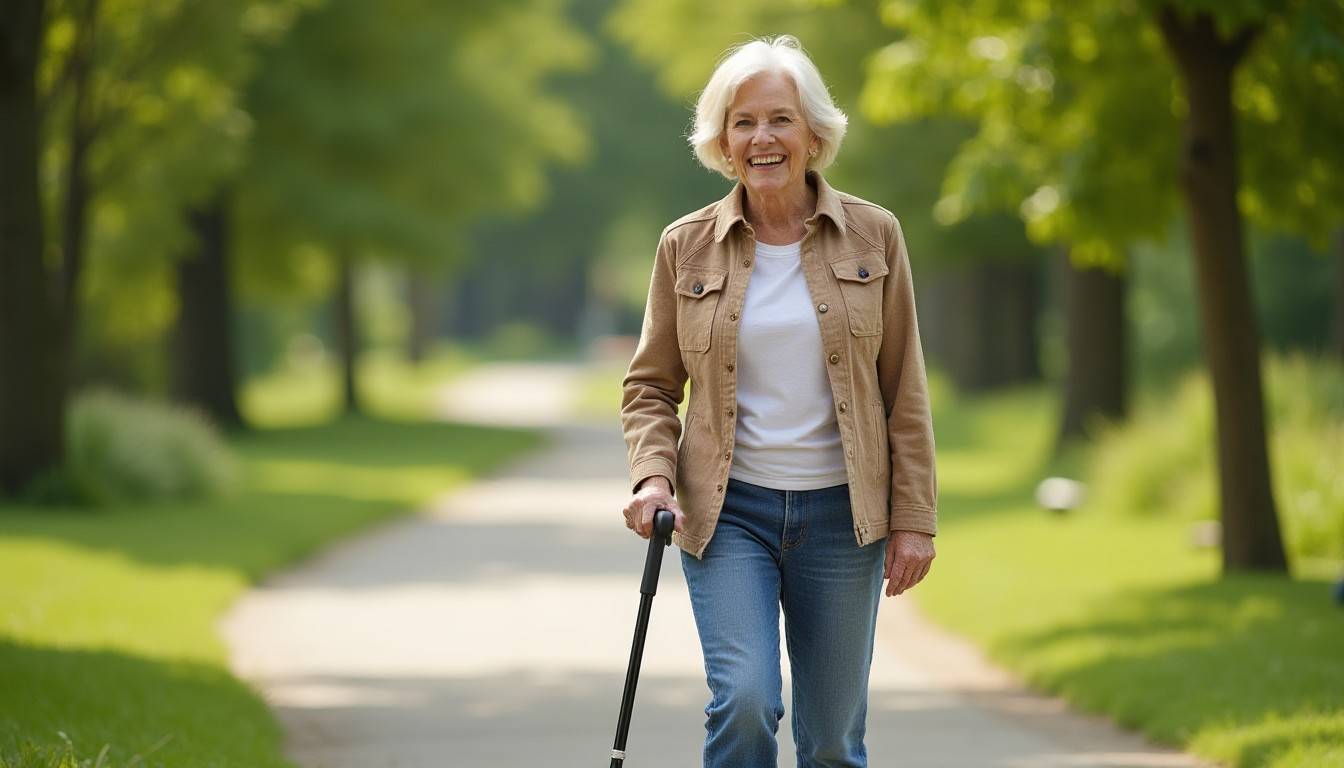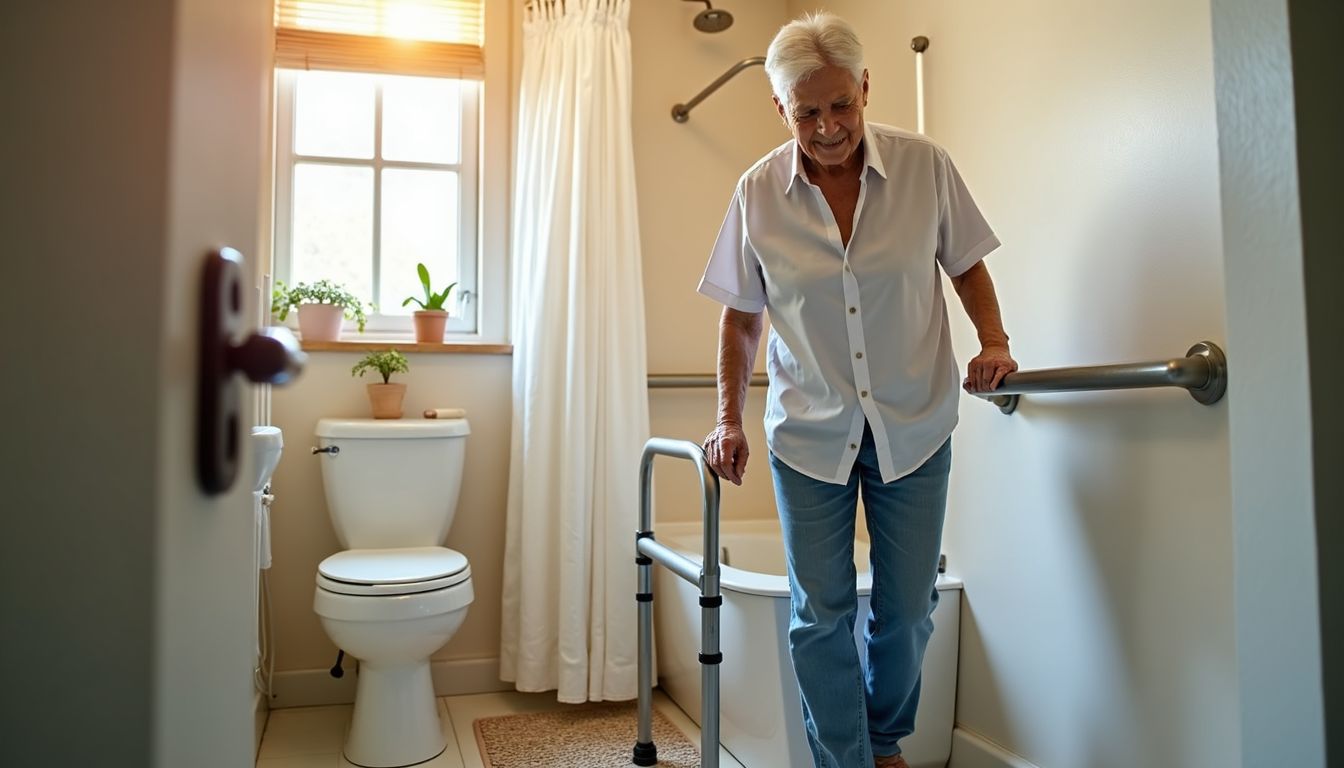Introduction
As we age, maintaining mobility and independence becomes increasingly important. A cane for seniors is more than just a walking aid—it provides balance, stability, and confidence, helping prevent falls and injuries.
Whether recovering from surgery, managing arthritis, or simply needing extra support while walking, the right cane can make daily activities easier and safer. With so many options available, from standard canes to quad and folding canes, choosing the best one can feel overwhelming.
In this guide, we’ll help you understand the different types of canes, their key features, and top-rated options on Amazon USA, so you can make an informed choice and stay active with confidence.
Why Seniors Need a Cane
For seniors, even small challenges in walking can impact daily life. A cane for seniors is more than a mobility tool—it’s a safety companion that improves quality of life.
Here’s why using a cane is essential for older adults:
🌟 Key Benefits:
-
Improves Balance and Stability – Canes provide extra support, reducing the risk of slips and falls.
-
Supports Weak or Injured Legs – Whether due to arthritis, surgery, or general weakness, a cane helps distribute weight and ease pressure.
-
Enhances Confidence While Walking – Seniors feel more secure when moving around, indoors or outdoors.
-
Promotes Independence – With the right cane, seniors can continue daily activities without needing constant help.
-
Reduces Fatigue – A cane helps conserve energy by taking some of the strain off legs and joints.
Choosing the right cane isn’t just about style—it’s about safety, comfort, and functionality.
Types of Canes for Seniors
Selecting the right cane is crucial for enhancing mobility, stability, and independence. Here’s an overview of the most common cane types:
1. Standard Canes
These are single-point canes, typically made of wood or lightweight metal. They offer basic support and are ideal for individuals who need minimal assistance.
Example:
-
Giri Wooden Walking Stick
Description: A handcrafted wooden cane that combines elegance with functionality. Its traditional design provides reliable support for daily use.
2. Folding Canes
Designed for portability, folding canes collapse into a compact size, making them easy to store and travel with. They are suitable for seniors who need a cane occasionally or while traveling.
Example:
-
DMI Adjustable Folding Cane
Description: This cane features adjustable height settings and folds for easy storage, making it perfect for on-the-go use.
3. Quad Canes
Featuring a four-point base, quad canes offer enhanced stability and balance. They are ideal for seniors with significant mobility challenges or those recovering from surgery.answers.avacaremedical.com
Example:
-
Hugo Mobility Quadpod Cane
Description: Equipped with a large base and ergonomic handle, this cane provides superior support and comfort.
4. Offset Handle Canes
These canes have a handle that is offset to align with the user’s wrist, reducing strain on the hand and wrist. They are beneficial for individuals with arthritis or joint pain.
Example:
-
Medline Offset Handle Cane
Description: Designed to reduce wrist strain, this cane offers a comfortable grip and adjustable height.
5. LED Canes
Incorporating built-in LED lights, these canes illuminate the path ahead, enhancing visibility during nighttime walks or in low-light conditions.
Example:
-
Trusty Cane with LED Light
Description: This cane features an LED light in the handle, providing illumination for safer nighttime use.
6. Designer Canes
Combining functionality with fashion, designer canes come in various styles and colors, allowing seniors to express their personality while maintaining mobility support.
Example:
-
Brazos Rustic Wood Walking Stick
Description: A beautifully crafted cane with a twisted hickory design, offering both style and stability.
Key Features to Look for in a Cane
Choosing the right cane for seniors is not just about style—it’s about safety, comfort, and functionality. Here are the most important features to consider:
1. Handle Type
-
Ergonomic Handles: Designed to fit the natural shape of the hand, reducing strain on joints.
-
Offset Handles: Helps distribute weight evenly, easing wrist and hand pressure.
-
Soft Grip Handles: Comfortable for long-term use, especially for seniors with arthritis.
2. Height Adjustability
-
A cane should be adjustable to match the user’s height.
-
Proper height ensures good posture, reduces fatigue, and improves balance.
-
Tip: When standing upright, your elbow should bend about 15–20° while holding the cane.
3. Material
-
Aluminum: Lightweight and durable, ideal for everyday use.
-
Wood: Classic look, sturdy but heavier.
-
Carbon Fiber: Lightweight, strong, and sleek, usually premium models.
4. Base Type
-
Single Tip Cane: Standard, suitable for minimal support needs.
-
Quad Cane: Four-point base offers maximum stability, ideal for seniors with balance issues.
5. Special Features
-
Folding Mechanism: Great for travel or easy storage.
-
LED Lights: Enhances visibility during nighttime walks.
-
Built-in Seat or Handle Accessories: Some models offer extra comfort features for convenience.
Choosing a cane that meets these criteria ensures maximum safety, comfort, and independence for seniors.
How to Use a Cane Safely
Using a cane correctly is essential for maximizing safety and mobility. Here are some practical tips for seniors to get the most out of their cane:
1. Hold the Cane on the Opposite Side
-
Always hold the cane in the hand opposite to the weaker or injured leg.
-
This provides proper support and balances your weight while walking.
2. Step With the Weaker Leg First
-
Move the cane forward along with your weaker leg.
-
Then step through with your stronger leg.
-
This sequence ensures stability and reduces strain.
3. Maintain Proper Posture
-
Keep your back straight and shoulders relaxed.
-
Avoid leaning too much on the cane; it should assist, not carry your full weight.
4. Adjust Cane Height Correctly
-
Your elbow should bend about 15–20° when holding the cane.
-
The right height improves comfort and balance, preventing fatigue.
5. Walk on Even Surfaces When Possible
-
Avoid slippery or uneven surfaces to reduce the risk of falls.
-
Use rubber tips or quad cane bases for extra grip.
6. Take Small, Controlled Steps
-
Avoid rushing or long strides.
-
Slow and steady movements enhance balance and confidence.
7. Regularly Inspect Your Cane
-
Check for wear and tear, loose parts, or worn-out rubber tips.
-
Replace or repair parts as needed to maintain safety.
Tips for Maintaining Your Cane
A cane is an investment in safety and independence, so keeping it in good condition is important. Here are some practical maintenance tips for seniors:
1. Regular Cleaning
-
Wipe the cane with a damp cloth to remove dirt and dust.
-
For wooden canes, use a mild polish to keep the surface smooth and protected.
2. Check the Cane Tip
-
Inspect the rubber tip regularly for wear or cracks.
-
Replace worn-out tips immediately to maintain grip and prevent slips.
3. Tighten Screws and Bolts
-
Folding or adjustable canes often have screws and bolts.
-
Check them periodically to ensure the cane stays stable and safe.
4. Store Properly
-
Keep the cane in a dry place to prevent rust or damage.
-
Avoid leaving it leaning at awkward angles that could bend or weaken it.
5. Avoid Overloading
-
Canes are designed to assist, not fully support body weight.
-
Avoid using it as a support for carrying heavy items to prevent damage.
By following these simple steps, seniors can extend the life of their cane and continue using it safely every day.
FAQs About Canes for Seniors
Q1: How do I choose the right cane for my height?
A: Stand upright and let your arms hang naturally. The cane handle should reach the crease of your wrist, allowing your elbow to bend about 15–20° when holding it.
Q2: What is the difference between a standard cane and a quad cane?
A: A standard cane has a single tip and is best for mild support. A quad cane has a four-point base, offering maximum stability and balance for seniors with more significant mobility challenges.
Q3: Can I use a cane if I have arthritis?
A: Yes! Look for ergonomic or padded handles to reduce strain on your hands and wrists. Adjustable height and lightweight materials also make walking more comfortable.
Q4: How often should I replace the cane tip?
A: Check the tip every few months or sooner if you notice wear or cracks. Worn tips can reduce stability and increase the risk of falls.
Q5: Can I travel with my cane?
A: Absolutely. Many canes are foldable or lightweight, making them convenient for travel. Some even feature LED lights for safe night use.
Conclusion & Final Tips
Ensuring shower safety and mobility for seniors starts with choosing the right support tools, like canes, walkers, or rollator chairs. A well-selected cane not only improves balance and stability but also boosts confidence and independence in daily life.
Final Tips for Seniors:
-
Always choose a cane that matches your height, weight, and mobility needs.
-
Prioritize comfort and grip to prevent hand or wrist strain.
-
Regularly inspect your cane for wear, and replace tips or parts as needed.
-
Combine the cane with other safety measures at home, like grab bars and non-slip mats, to further reduce the risk of falls.
-
Take your time when walking, and use proper techniques to maximize safety.
By following these tips and choosing a quality cane, seniors can maintain independence, move safely, and enjoy daily activities with confidence.
Choosing the right canes for seniors can greatly enhance stability and confidence while walking. For those who prefer additional support, a rollator walker with seat or a folding walker for elderly can provide extra balance and convenience. Seniors looking to improve mobility and strength may also benefit from low-impact exercises like our 10 Easy Mobility Exercises for Seniors. Pairing mobility aids with safety products like Non-Slip Slippers for Elderly Men helps prevent falls at home.







